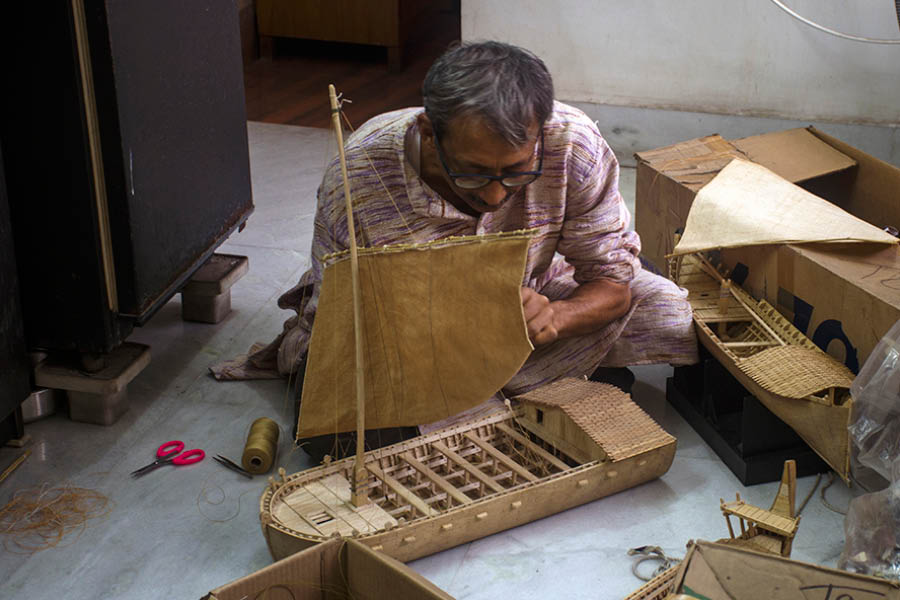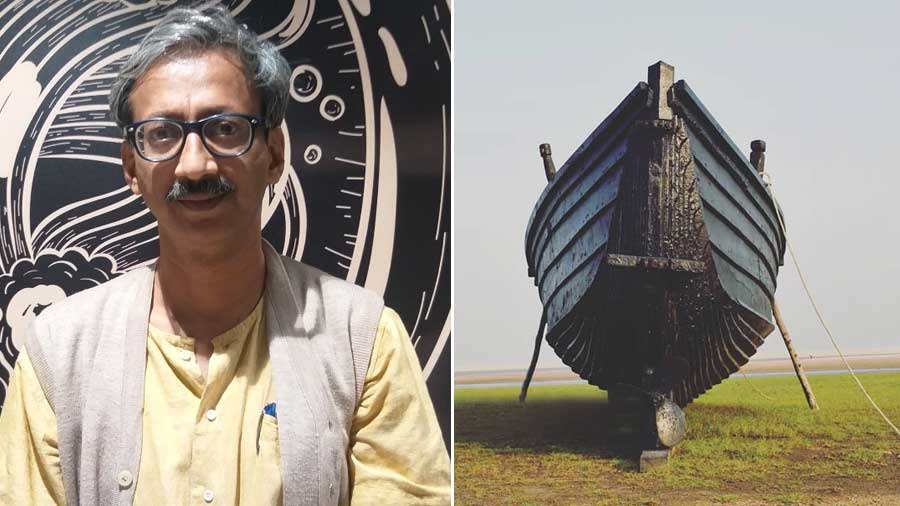Swarup Bhattacharyya is popularly known as the ‘Boatman of Bengal’ for his three-decade-long anthropological research on Bengal boats. But unknown to many, he is also an artist who specialises in making miniature scale models of different varieties of Bengal boats.
The inspiration probably came from his late father Madhab Bhattacharjee, a reputable artist and former exhibition officer of Birla Industrial and Technological Museum.
The idea of model boats came to the junior Bhattacharyya in February 2006, when he held an exhibition at the Indira Gandhi National Centre of Art (IGNCA). Apart from 115 photographs of boats, the exhibit also contained several models of boats out of which five were completed models of boat. Also in the exhibit were 15 incomplete boats showing the different stages of production.
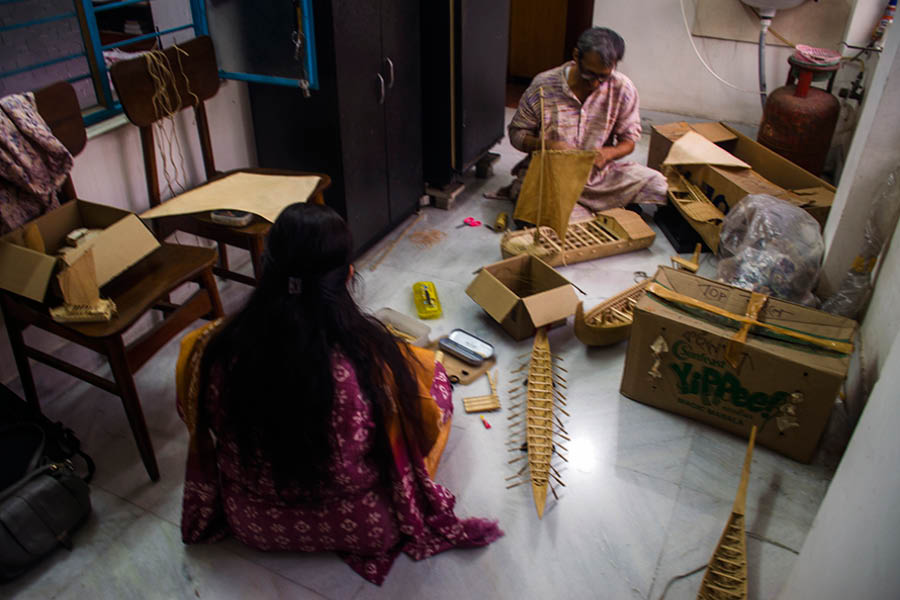
Anupurba Banerjee and Swarup Bhattacharyya assemble the model boats before the exhibition.
After the exhibition in IGNCA, model boat making took a back-stage as Bhattacharyya was back with his field work of boat research. But during the long lockdown period of Covid-19, Bhattacharyya’s artistic side re-emerged and he got involved in model boat-making. This time assisted by his wife, Anupurba Banerjee, they made several scale models using balsa and gamhar wood. The models were complete with sails and other accessories, including radar, anchor, oars and many more.
Khadi cloth is used for sails and they were dipped in coffee solutions for the colour. The Bhattacharyya couple applied various innovations like using fishing hooks for making anchors.
Today, the Bhattacharyya couple has a collection of about 15 types of boats, excluding repetition of the same boats on different scales. The model boats range from half feet to three feet in length. In the past couple of months, the models have been displayed in several exhibitions across Kolkata, where they were up for display and sale. The latest one happening at Anita Banerjee Memorial Hall in Jadavpur University from May 2 to 4.
Below are details of some of the model boats:
Barki
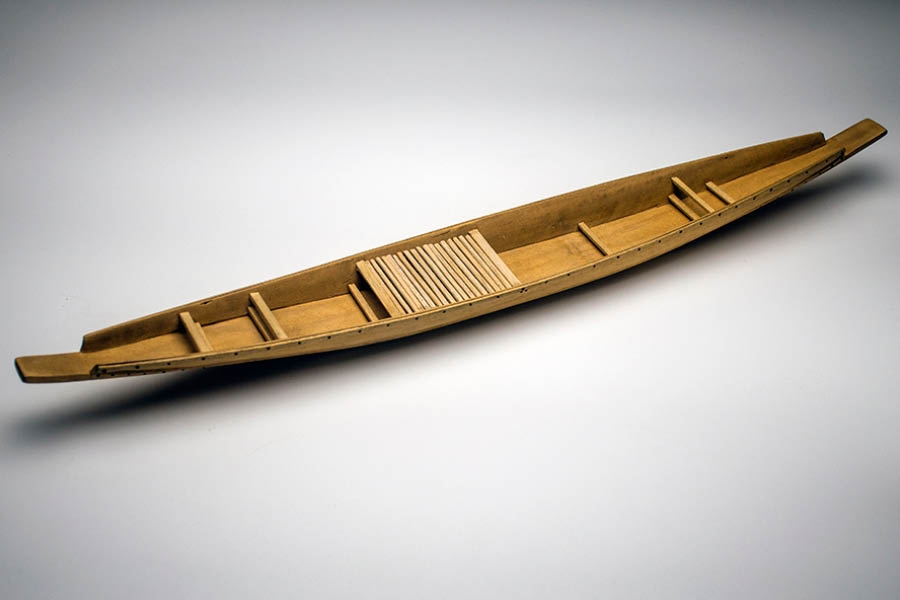
It is an all-purpose boat used both for fishing and cargo handling. Fishing Barki are wider in respect of cargo Barki. The entire nailed boat has protruding central part. Mainly used in the Chittagong area of Bangladesh. Length of the boat varies from 20 to 40 haat. (Haat is an indigenous measurement and is equal to the distance between the elbow and finger tip of a person. It is roughly equal to 1.5 feet) (Scale: 1:40)
Betnai

It was used in carrying gol pata (Nypa fruticans) and garan wood (Ceriops decandra) from Sunderbans. But at present, these forest items are prohibited and so there is no need for betnai any more. It is an extinct boat. Betnai was a large boat usually measuring 40 to 50 haat in length. It used tidal current efficiently for its movement though it also used square sails sometimes for propulsion. (Scale 1:60)
Chhip
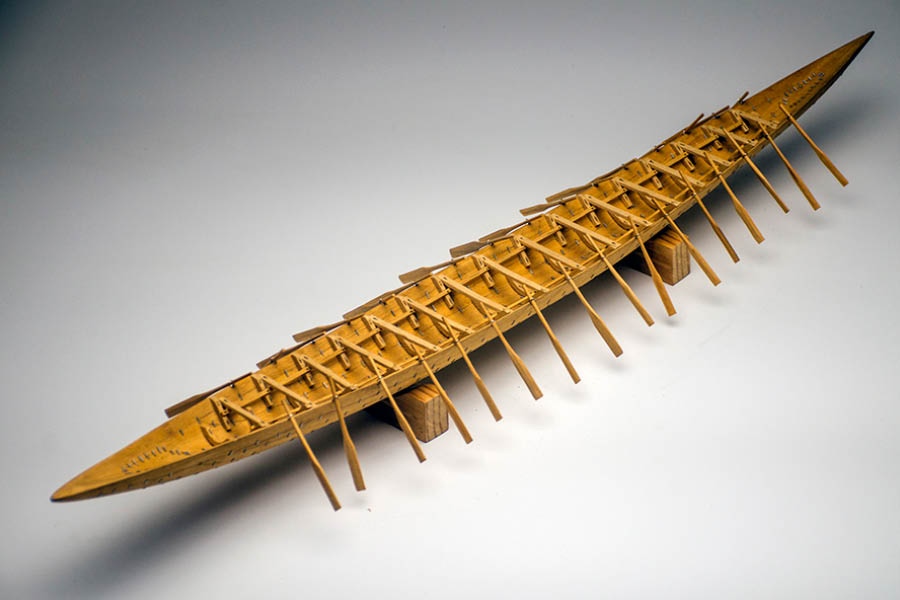
A shell built long and narrow paddled racing boat. Length of the boat can be 60 to 70 haat. Hundred paddlers can accommodate. Nouka Baich is the popular traditional water sport of Bengal where these types of racing boats took part. Chhip may have connection with war in the riverine Bengal in the medieval period. (Scale 1:70)
Dungi
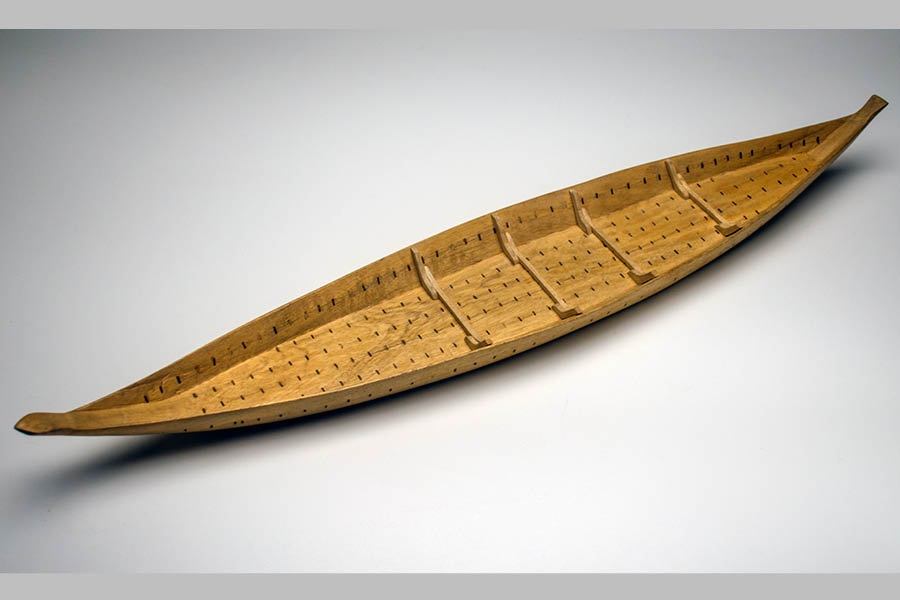
It is essentially a small fishing boat of Subarnarekha river of West Bengal. Flat bottom with the planks joined by staple like pins. Propelled by paddle, not ore. Paddles unlike oars are not fixed to the body of the boat. In case of ore the boat moves in the backward direction of the rower. Fir paddle it moves in forward direction. (Scale 1:25)
Kalia Bachari

A shell built long and narrow paddled racing boat of Bangladesh. Length of the boat can be 60 to 70 haat*. Hundred paddlers can accommodated. The shape of the boat derived from a fish. Striking features are the long stem and stern heads with elaborate adornment. (Scale: 1:100)
Khorokisti
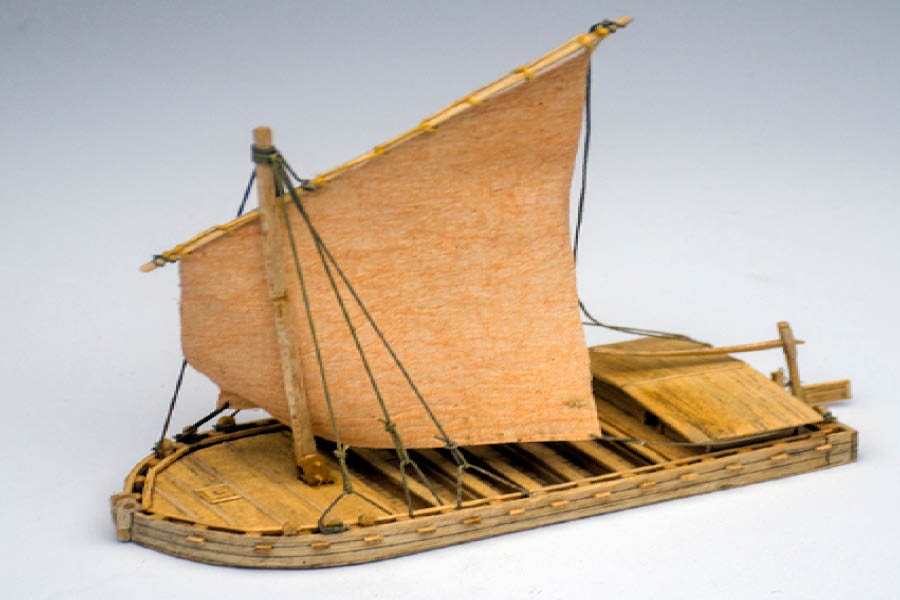
Khor means straw and kisti is the Arabic word for boat. So, khorokisti is a straw carrying boat. It is a flat bottomed boat measuring fifty haat in length and fifteen haat in width. Shallow draft Khorokisti used to ply from Geonkhali of Medinipur district to Sundarban to load three fifty to four hundred kahon (a unit to measure the amount of straw) of straw and unload it in different parts of Kolkata. This boat is entirely nailed and propelled by sail. As fully loaded Khorokisti was unable to move on its own and was towed by a small boat called Chhot. Later on Chhot was replaced by motorised launch. (Scale: 1:150)
Kosa
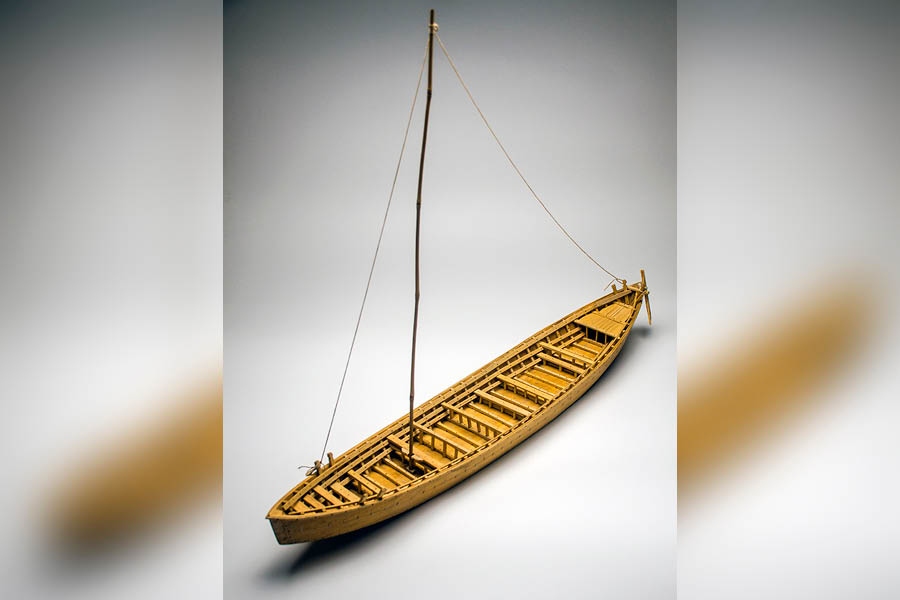
Kosa is a typical flat-bottomed boat. It is used in the shallow rivers of north Bengal for fishing and carrying commodities. Two ends of kosa are narrow and pointed and so it can easily be propelled along the against current of the turbulent rivers of north Bengal. While going southward it uses square sail but it needs to be towed while going northward. (Scale: 1:50)
Paukiya
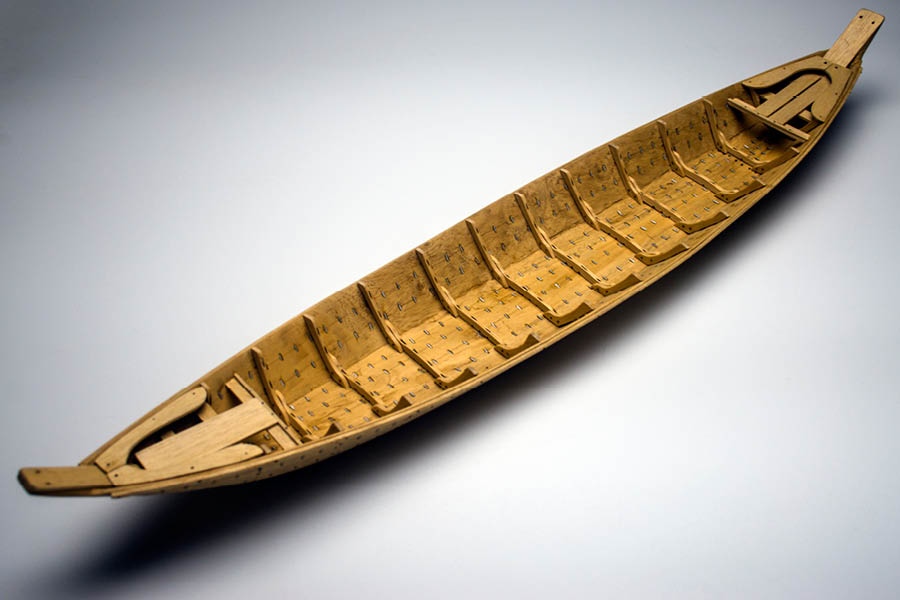
A boat of Medinipur. Found in many parts of the district in various forms. Paukiya of Moyna is essentially a boat for transporting goods, whereas Paukiya of Egra is for fishing. Paukiya of Bachhurmari is for estuary fishing and Paukiya of Digha is for coastal fishing. (Scale: 1:30)
Sultani
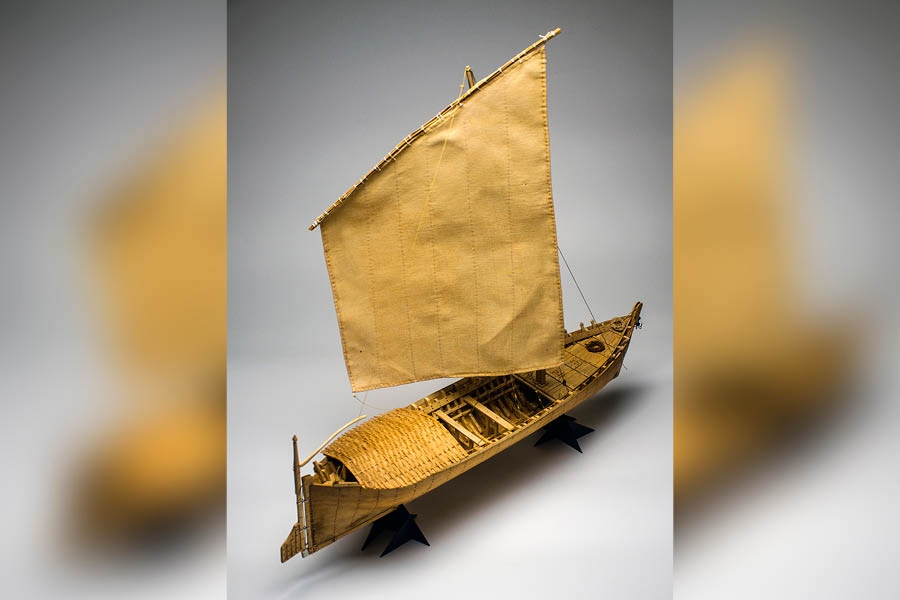
It is made to carry cargo to the mouth of the Hooghly. Its length is 50 to 60 feet and it carries commodities like vegetables, groceries, bricks, sands, cement etc. from the Sunderbans to the mouth of the river. The technology used in making the boat is very different from any other boat type of Bengal. The plank joinery, shape of rudder, the structure of mast and the shape of sail are unique in style. So people do not consider it as a common boat. They call it ‘boat’; instead of nouka in local dialect. (Scale: 1:50)
Taler donga

Palm dugout. Widely used all over Bengal. Used as household vehicle during flood in low-lying areas. (Scale: 1:10)
